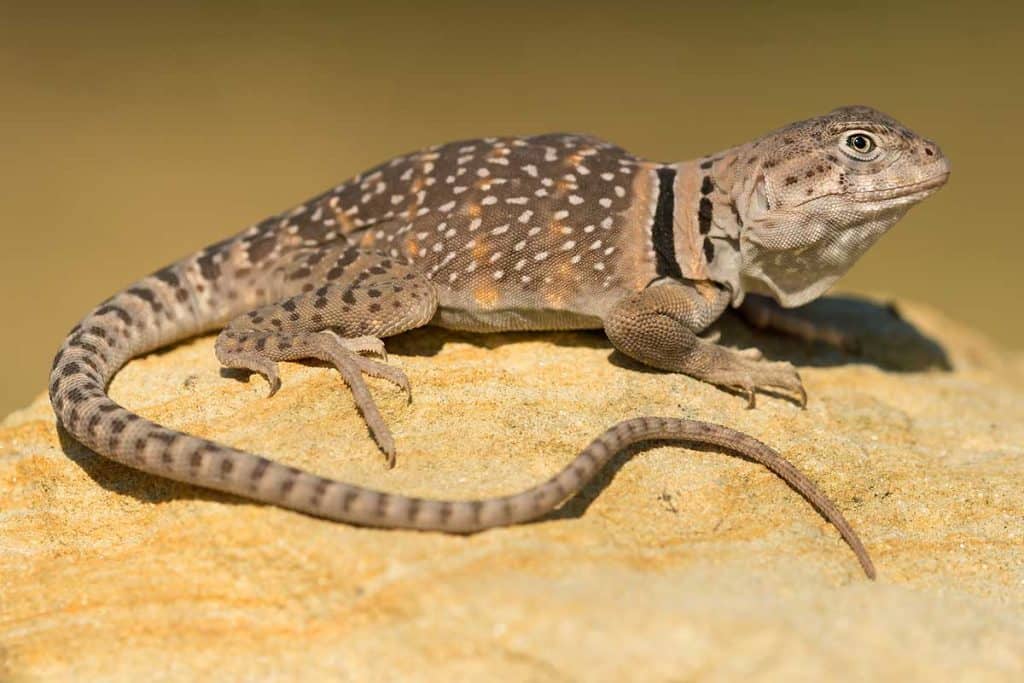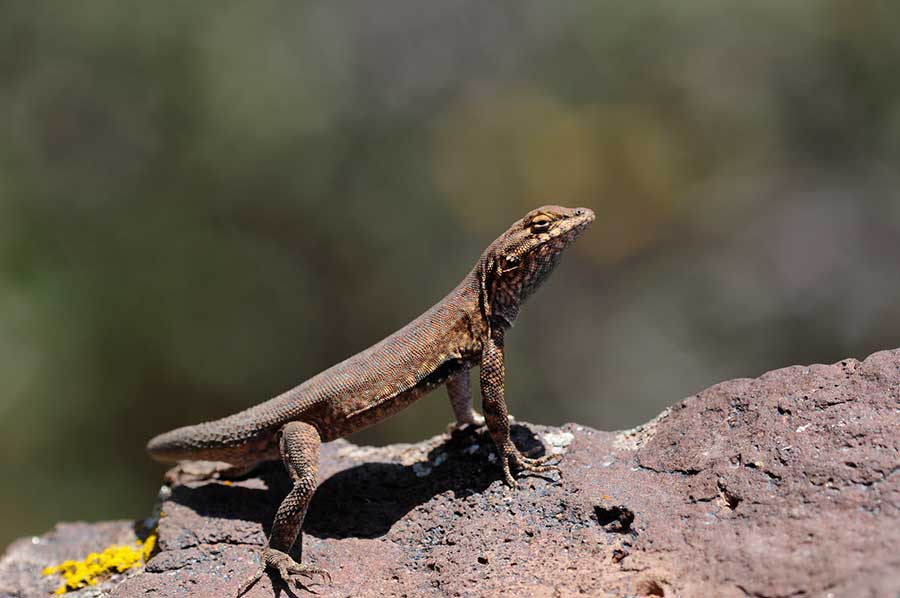We tend to think of the desert as an inhospitable place where it is challenging to survive, because humans have not evolved to live in the desert. But there are many species of lizard that have evolved specifically to live in these arid conditions, and the desert gives them everything they need to survive.
Just in the American deserts, you can expect to encounter bearded dragons, chuckwallas, collared lizards, Gila monsters, greater earless lizards, horned lizards, iguanas, western banded geckos, and side-blotched lizards, among others.
But what do desert lizards eat and how do they stay hydrated in arid desert conditions? In this article, we’ll look at exactly that, and what you can feed a desert lizard at home if you are keeping one as a pet.
What Do Desert Lizards Eat in the Wild?
While we often talk about lizards as a generic group, no two lizard species are the same, and there are more than 6,000 different known species of lizard. And they don’t all eat the same things. This is even true of desert lizards.
The desert horned lizard, for example, lives in the deserts of North America and eats mainly ants, beetles, and flies. Meanwhile, collared lizards eat mainly crickets, grasshoppers, and invertebrates. Larger common chuckwallas and iguanas are herbivores and eat leaves, fruits, and flowers from the desert. Nocturnal banded geckos prefer spiders and baby scorpions. The giant Gila monster eats mostly insects but will also eat small mammals and birds on occasion.
So, you really do need to research the specific species of desert lizard to know what exactly they eat, but we can make a few generalizations.
- Most desert lizards will survive principally on insects including crickets, grasshoppers, beetles, flies, and mealworms.
- Some will also eat invertebrates such as snails and worms.
- Some will eat leaves, fruit, and other vegetation native to the desert. These lizards often live near oases where these are more plentiful.
- Some desert lizards, such as skinks, will mainly feed on eggs.
- Some larger lizards will eat small mammals and other lizards in the desert.
What about hydration?
Desert lizards can survive with very little water because they are good at retaining the water that they do imbibe. Remember, lizards can’t sweat because their scales create a watertight seal. They also pass very little water when they urinate, just urates (salts derived from uric acid).
But this does not mean that they need no water at all. They might lick up a droplet if they come across it, but most desert lizards are able to draw water up through the sand. Their stomachs allow them to attract underground water.
Their skin is then covered by a network of tiny tube-like channels beneath their scales, which cover their entire bodies. This channels any water they come into contact with towards the mouth for drinking.
Sourcing Your Desert Lizard’s Food
To know what to feed your lizard in the wild, you will need to research their specific breed and then try and find food items that are right for them. They might need crickets and grasshoppers, but they might also benefit from small mammals such as mice.
Ideally, you will want to source these fresh from a local dealer. But picking up live crickets and small mice in your local area is not always possible. When it comes to insects, freeze-dried insects are a good alternative. The freeze-drying process preserves the nutrients of the insect.
If your lizard is a carnivore that can eat small portions of animal or bird meat, you can give them small raw pieces that you get from the butcher. Ideally, this should be cut into pieces no bigger than the space between your lizard’s eyes to ensure they can properly swallow it.
For an herbivore, finding desert plants to feed your lizard can be challenging, but they can eat a variety of other fruits and vegetables. The best choices include dark leafy greens, yellow squash, apples, firm melons, celery, carrots, prunes, blueberries, mangos, pineapple, pear, and grapes. Again, cut these into pieces no bigger than the space between your lizard’s eyes.
There are a few fruits and vegetables to avoid giving your lizard as they can be toxic depending on their species. These include iceberg lettuce, avocado, onion, garlic, eggplant, and citrus fruits.
How to Prepare Your Desert Lizard’s Food
You can give your lizard live or freeze-dried insects and small pieces of meat and vegetable matter by just placing it in the feeding section of their tank. The most important thing to remember is to keep pieces smaller than the space between your lizard’s eyes for easy digestion and to prevent choking.
Another popular approach is to blend the appropriate food for your lizard into a kind of sausage and let them munch away on it. Just put everything into a food blender and then feed into edible sacks.
How much food your lizard needs depends on their size, species, gender, activity level, and a variety of other factors. But desert lizards will then eat their fill and stop eating. So, you can feed them as much as they will take, two or three times a week. After a while, you should have a good idea of how much to give them. Lizards tend to put on weight slowly, so if they seem to get bigger suddenly, this is a sign that you are overfeeding them.
Regardless of your lizard’s species, most need a lot of variety in their diet. You should try and rotate through the different foods they have adapted to eat. If their diet is too restricted, it can end up in vitamin deficiencies and even metabolic bone disease.
Warning! Whatever you do, don’t give your lizard any of your own food just to see if they will like it. Grains, anything high in sugar or fat, and processed foods are all dangerous for lizards. Even if you are having a steak, the onion and garlic that may have been used in preparation is not good for your lizard. And chocolate is extremely toxic.
Vitamin Supplements for Desert Lizards
Even on the most carefully controlled and lovingly administered diets, desert lizards kept in captivity tend to suffer from vitamin deficiencies and therefore benefit from a vitamin supplement.
While vitamin supplements for lizards contain a variety of ingredients,
We recommend using a supplement like Zoo Med Repti
Additionally, in order to metabolize
Supplements will also often contain vitamin D3, but this is not always the best source. Too much dietary vitamin D3 can flood your lizard’s system and leave them unable to properly utilize it, but vitamin D obtained from direct sunlight does not act in the same way.
In short, be sure to buy a
FAQs About Desert Lizard Diets
What is the main food for desert lizards?
Every desert lizard is different. Some are insectivores, others will also eat meat, and some are herbivores living on desert foliage and fruits. But for most desert lizards that aren’t herbivores, insects will make up a good portion of their diet.
What can I feed the lizard in my backyard?
If you have a wild lizard in your garden, you don’t need to feed it. They are good at fending for themselves and are probably hunting insects and invertebrates that you have in your garden. If you want to give them something as a treat, a piece of apple or berries are often a good choice.
The Verdict
There are many different breeds of desert lizard, and they all eat different things. Some are herbivores while others eat insects, and some will even eat small animals and other lizards. If you are keeping one in captivity and want to know what to feed them, you need to do your research.
There is nothing better for them than fresh prey, so if you can source live insects and small mammals then do. But if that isn’t possible where you live, freeze-dried options are often your best alternative.
Do you have a desert lizard at home? What do you do to keep them healthy? Share your thoughts with the community in the comments section below.




